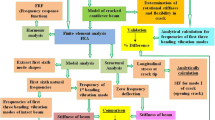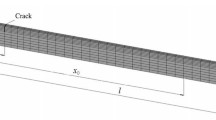Abstract
The results of experimental investigation of the relationship between the natural frequency of the first mode bending and longitudinal vibrations of titanium alloy and alloyed steel cantilever beams and the crack parameters (crack depth and location) are presented together with the data on calculation of the relative change of the vibration frequency of cracked beams, which are obtained by the proposed analytical approaches. Based on a comparative analysis, we choose fairly simple and sufficiently accurate formulas for calculating the frequencies of bending and longitudinal vibrations of a cantilever beam with an open or closing crack.
Similar content being viewed by others
References
A. P. Bovsunovskii, “On determination of the natural frequency of transverse and longitudinal vibrations of a cracked beam. Part 1. Analytical approach,”Probl. Prochn., No. 2, 35–44 (1999).
A. P. Bovsunovskii, “Application of the strain-phase-shift method for the determination of damping in metals,”Exper. Mech.,36 (3), 243–250 (1996).
V. T. Troshchenko,Deformation and Fracture of Metals under High-Cycle Loading [in Russian], Naukova Dumka, Kiev (1981).
N. N. Davidenkov, “Review. On energy dissipation in vibration,”Zh. Tekh. Fiz.,8, Issue 6, 483–499 (1938).
G. E. Vizerskaya, “Estimation of the influence of air resistance on the damping characteristics of a vibrating system of a D-8 setup,”Probl. Prochn., No. 11, 113–114 (1972).
V. V. Matveev,Damping of Vibration of Deformable Bodies [in Russian], Naukova Dumka, Kiev (1985).
F. D. Ju, M. Akgun, E. T. Wang, and T. L. Lopez, “Modal method in diagnosis of fracture damage in simple structures,”ASME Publication AMD,52, 113–126 (1982).
P. Gudmundson, “The dynamic behavior of slender structures with cross-sectional cracks,”J. Mech. Phys. Sol.,31 (4), 329–345 (1983).
R. Actis and A. D. Dimarogonas, “Non-linear effects due to closing cracks in vibrating beams,”ASME Publ. DE 18-3, 99–104 (1989).
M. -H. H. Shen and C. Pierre, “Free vibrations of beams with a single-edge crack,”J. Sound Vibration,170 (2), 237–259 (1994).
G. Gounaris, N. Anifantis, and A. D. Dimarogonas, “Dynamics of cracked hollow beams,”Eng. Fract. Mech.,39 (6), 931–940 (1991).
Additional information
Institute of Problems of Strength, National Academy of Sciences of Ukraine, Kiev, Ukraine. Translated from Problemy Prochnosti, No. 3, pp. 45–53, May–June, 1999.
Rights and permissions
About this article
Cite this article
Bovsunovskii, A.P. On determination of the natural frequency of transverse and longitudinal vibrations of a cracked beam. Part 2. Experimental and calculation results. Strength Mater 31, 253–259 (1999). https://doi.org/10.1007/BF02511004
Received:
Issue Date:
DOI: https://doi.org/10.1007/BF02511004




